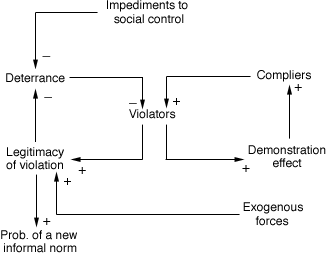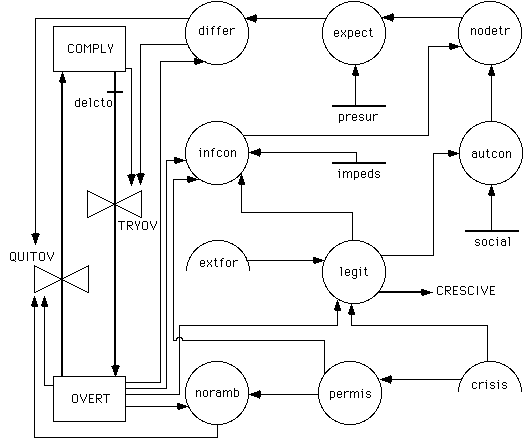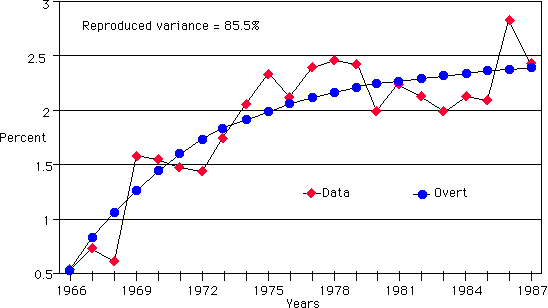
Chanoch Jacobsen and Tamar
Vanki (1996) 'Violating an Occupational Sex-Stereotype: Israeli Women Earning
Engineering Degrees'
Sociological Research Online, vol. 1,
no. 4, <http://www.socresonline.org.uk/1/4/3.html>
To cite from articles published in Sociological Research Online, please reference the above information and include paragraph numbers if necessary
Received: 18/8/96 Accepted: 12/12/96 Published: 23/12/96
 Abstract
Abstract Introduction
Introduction
 Theory and Model
Theory and Model


 Data and Simulation
Data and Simulation
| Women | Men | ||||
|---|---|---|---|---|---|
| Year | Total Graduates | Enginineering Graduates | % Engineering | Total Graduates | % Engineering |
| 1966 | 931 | 5 | 0.537 | 1245 | 30.92 |
| 1967 | 1245 | 9 | 0.723 | ||
| 1968 | 1330 | 8 | 0.602 | ||
| 1969 | 1512 | 24 | 1.587 | ||
| 1970 | 1742 | 27 | 1.550 | ||
| 1971 | 1842 | 27 | 1.466 | ||
| 1972 | 2012 | 29 | 1.441 | ||
| 1973 | 2174 | 38 | 1.748 | ||
| 1974 | 2259 | 46 | 2.036 | ||
| 1975 | 2490 | 58 | 2.329 | 3059 | 42.56 |
| 1976 | 2548 | 54 | 2.119 | ||
| 1977 | 2596 | 62 | 2.388 | ||
| 1978 | 2643 | 92* | 3.481 | ||
| 1979 | 2814 | 68 | 2.416 | ||
| 1980 | 3238 | 64 | 1.977 | 3564 | 34.32 |
| 1981 | 3358 | 75 | 2.233 | ||
| 1982 | 3455 | 73 | 2.119 | ||
| 1983 | 3688 | 73 | 1.979 | ||
| 1984 | 3851 | 82 | 2.129 | ||
| 1985 | 3957 | 83 | 2.098 | ||
| 1986 | 4256 | 120 | 2.820 | ||
| 1987 | 4339 | 105 | 2.420 | 4410 | 24.01 |
| Variable | Lower Limit | Assumed Value | Upper Limit | Range | |
|---|---|---|---|---|---|
| Potential Violators (PRESUR) | (%) | 2.4 | 2.5 | 2.9 | 0.5 |
| Overt Violators (OVERT) | (%) | 0.5 | 0.5 | 0.9 | 0.4 |
| Socialization (INSOC) | (%) | 50.0 | 90.0 | 100.0 | 50.0 |
| Impediments (IMPEDS) | (%) | 1.0 | 10.0 | 100.0 | 9.9 |
| Permissiveness (PERMIS) | (%) | 2.4 | 5.0 | 9.9 | 7.5 |
| Legitimacy (INLEG) | (%) | 10.0 | 40.0 | 53.0 | 43.0 |
| Violation Delay (DELCTO) | (yrs) | 3.3 | 4.3 | 5.7 | 2.4 |
 Results And Discussion
Results And Discussion

| Year | Autonomous Control (AUTCON) | Informal Control (INFCON) | Legitimacy (LEGIT) | Overt Violators (OVERT) |
|---|---|---|---|---|
| 1966 | 73.03 | 10.57 | 40.0 | 0.53 7 |
| 1967 | 69.59 | 8.50 | 40.2 | 0.827 |
| 1968 | 64.33 | 5.94 | 42.5 | 1.068 |
| 1969 | 59.04 | 3.95 | 44.5 | 1.273 |
| 1970 | 54.67 | 2.60 | 46.2 | 1.448 |
| 1971 | 51.09 | 1.66 | 47.7 | 1.596 |
| 1972 | 47.37 | 1.16 | 49.3 | 1.722 |
| 1973 | 44.22 | 0.82 | 50.7 | 1.829 |
| 1974 | 41.62 | 0.59 | 52.0 | 1.921 |
| 1975 | 39.47 | 0.48 | 53.0 | 1.998 |
| 1976 | 37.70 | 0.38 | 53.9 | 2.064 |
| 1977 | 36.23 | 0.31 | 54.6 | 2.119 |
| 1978 | 34.92 | 0.25 | 55.2 | 2.166 |
| 1979 | 33.69 | 0.23 | 55.8 | 2.205 |
| 1980 | 32.65 | 0.22 | 56.2 | 2.239 |
| 1981 | 31.78 | 0.21 | 56.6 | 2.268 |
| 1982 | 31.05 | 0.20 | 56.9 | 2.292 |
| 1983 | 30.44 | 0.19 | 57.2 | 2.313 |
| 1984 | 29.92 | 0.19 | 57.4 | 2.331 |
| 1985 | 29.48 | 0.18 | 57.6 | 2.345 |
| 1986 | 29.12 | 0.18 | 57.8 | 2.358 |
| 1987 | 28.81 | 0.18 | 58.0 | 2.369 |
 Acknowledgments
Acknowledgments
 Appendix: Acronyms, Variables and their
Definitions
Appendix: Acronyms, Variables and their
Definitions
BERGER, P. & LUCKMAN, T. (1967) The Social Construction of Reality. New York: Anchor Books.
BRIDGES, J. S., & BOWER, M. S. (1985) 'The Effect of Perceived Job Availability for Women in College: Women's Attitudes Towards Prestigious Male-Dominated Occupations', Psychology of Women Quarterly, vol. 9, pp. 265 - 77.
CENTRAL BUREAU OF STATISTICS (1987) Statistical Abstract of Israel, Vol. 38. Jerusalem: Prime Minister's Office.
DITTON, J. (1977) Part-Time Crime: An Ethnography of Fiddling and Pilferage. London: Macmillan.
FITZPATRICK, J. L., & SILVERMAN, T. (1989) 'Women's Selection of Careers in Engineering: Do Traditional Differences Still Exist?', Journal of Vocational Behavior, vol. 43, pp. 266 - 78.
FORRESTER, J. W. (1961) Industrial Dynamics. Cambridge, MA: Wright-Allen.
HAMBLIN, R. L., BROOKE JACOBSEN, R. & MILLER, J. J. (1973) A Mathematical Theory of Social Change. New York: Wiley.
HOMANS, G. C. (1967) The Nature of Social Science. New York: Harcourt, Brace & World.
JACOBSEN, C. & BRONSON, R. (1985) Simulating Violators. Baltimore, MD: Operations Research Society of America.
JACOBSEN, C. & BRONSON, R. (1989) 'Thank You For Not Smoking: Simulating the Growth of a New Social Norm' in M. C. Jackson, P. Keys, and S. A. Cropper (editors) Operational Research and the Social Sciences. New York: Plenum.
JACOBSEN, C. & BRONSON, R. (1995) 'Computer Simulations and Empirical Testing of Sociological Theories', Sociological Methods and Research, vol. 23, no. 4, pp. 475 - 506.
JACOBSEN, C. & HANNEMAN, R. A. (1992) 'Illegal Drugs: Past, Present, and Possible Futures', Journal of Drug Issues, vol. 22, no. 1, pp. 105 - 120.
KVANDE, E. and RASMUSSEN, B. (1986) Women Challenge Technology. Oslo: Norwegian Institute of Technology.
MARS, G. (1974) 'Dock Pilferage: A Case Study in Occupational Theft' in P. Rock and M. McIntosh (editors) Deviance and Social Control. London: Tavistock Publications.
MERTON, R. K. (1957) Social Theory and Social Structure. Glencoe: Free Press.
OFFICE OF TECHNOLOGY ASSESSMENT (1988) Educating Scientists and Engineers: Grade School to Grad School. Washington, D.C.: U.S. Government Printing Office.
RICHARDSON, G. P. & PUGH, A. L. (1981) Introduction to System Dynamics Modeling with Dynamo. Cambridge, MA: M.I.T. Press.
SIMMEL, K. (1950) The Sociology of Georg Simmel. Translated by K. H. Wolff. New York: Free Press.
SMELSER, N. J. (1963) A Theory of Collective Behavior. New York: Free Press.
SUTHERLAND, E. H., & CRESSEY, D. R. (1960) Principles of Criminology. Chicago: Academic Press.
TECHNION (1987) Official Graduate Records, 1966- 1987. Haifa: Israel Institute of Technology.
WILLIAMS, R. M. Jr. (1951) American Society. New York: Knopf.
WIRTH, L. (1938) 'Urbanism as a Way of Life', American Journal of Sociology, vol. 44, pp. 3 - 24.